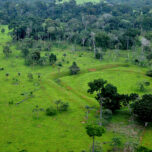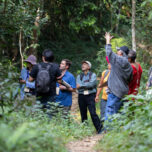|
“Experts and the world at large are recognizing that alternative approaches to research and socioeconomic development are needed that integrate modern scientific tools, basin-scale analysis, Indigenous knowledge and a conscious general public,” Trujillo told me last year, while we discussed conservation efforts, options and frustrations in the Colombian Amazon. “The survival of many species and cultures in the Amazon and other dynamic ecosystems depend upon these integrated approaches being adopted soon.”
Unfortunately, these and other adaptable complex frameworks remain much more the exception than the rule.
Toward a More Resilient Future
Based on my personal experience and the observed successes — and failures — of some of my colleagues who have worked with Indigenous communities for many years, here are some interrelated suggestions for those looking to engage with Indigenous communities in their territories:
1. Value different perspectives and practices. Before even considering working with Indigenous people, truly realize that their incorrectly labeled “quaint,” “backwards,” “primitive,” or impractically “mystical” worldviews are actually highly complex and developed. They are full of deep reason, extensive empirical knowledge and practical implications. In fact, they are the longest running successful experiments in sustainable human land use that exist on our increasingly stressed planet.
2. Listen, do not impose. Plan to have dialogue and to patiently and respectfully listen, learn and exchange ideas, not just instruct.
3. Treat Indigenous people as equal partners. Indigenous people are strategic partners in local, regional and global problem-solving, and while many Indigenous groups are extremely vulnerable due to a range of factors, they should not be treated as “charity cases” in need of rescuing.
4. Respect autonomy. Infringement upon Indigenous autonomy and prior consent is a deep and contentious issue for many Indigenous communities.
5. Let Indigenous people lead. Let those who know their circumstances and territories best determine their needs and drive the work whenever possible.
6. Do not be in a rush. Go with a long-term plan and structure for support — technical, financial or otherwise — not a “one and done” study, workshop or program. Many Indigenous people see short-term approaches as ineffective, unimportant and disrespectful.
7. Limit preconceived notions. Indigenous people are diverse and complex. They should not be expected to fit some stereotypical image seen on TV, or even studied in an academic setting.
Take an integrated approach. Do not go with a reductionist agenda. Indigenous people do not see individual problems or challenges as separated from the whole, so the reductionist approach will create discontinuity from the outset, even if equitable collaboration is the goal.
Tremendous diversity exists among Indigenous ethnic groups. But the fundamental complex and adaptive nature of indigenous socio-ecological systems offers an opportunity for effective intercultural collaboration around the world. Complex systems thinking and Indigenous worldviews, while different in method and perspective, can complement each other with common goals, such as the conservation and restoration of ecosystems. It is time for the great advances of Western science to catch up to the traditional interconnected thinking of Indigenous people, to help move us all forward toward a more resilient future.
Editor’s note: The views expressed here are those of the author and not necessarily of Ensia. We present them to further discussion around important topics. We encourage you to respond with a comment below, following our commenting guidelines, which can be found on this page. In addition, you might consider submitting a Voices piece of your own. See Ensia’s Contact page for submission guidelines.
Related Posts FeatureAncient Amazonian societies managed the forest intensively but sustainably — here s what we can learn from them FeatureAncient Amazonian societies managed the forest intensively but sustainably — here s what we can learn from them FeatureAs palm oil production ramps up in Africa, communities work to avoid problems plaguing other regions FeatureAs palm oil production ramps up in Africa, communities work to avoid problems plaguing other regions Notable7 recommendations for incorporating indigenous perspectives into biodiversity conservation
Show your support for nonprofit journalism! Notable7 recommendations for incorporating indigenous perspectives into biodiversity conservation
Show your support for nonprofit journalism!
Ensia shares solutions-focused stories free of charge through our online magazine and partner media. That means audiences around the world have ready access to stories that can and do help them shape a better future. If you value our work, please show your support today.
Yes, I'll support Ensia!
Republish
|